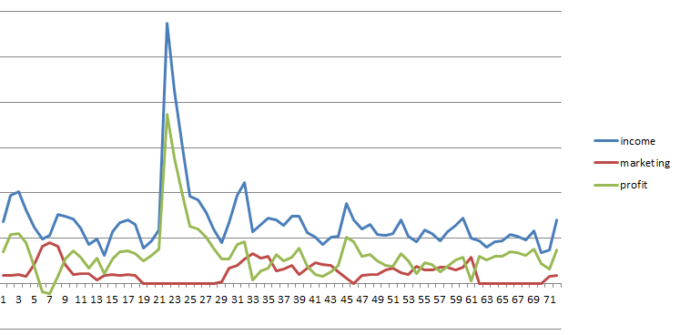I recently released Production Line update 1.29, so that’s 29 updates since the original release of the game, which was back in the pre-early access days, and just for people buying direct from my site. In that time, what’s happened?
Well, we have more than doubled the players of the game since going into Early Access, which is cool. Not surprisingly most people now buy direct from steam rather than through the humble widget, which means we earn noticeably less per sale, but that’s to be expected. Income from the game is ‘ok’, in that compared to Democracy 3 it hasn’t set the world on fire, but then the game has already paid for its dev costs (minus my salary, which I don’t count directly), and if I do the maths, its paying me a reasonable income for a senior software developer, so from a financial POV, things aren’t that bad at all.
Plus its still in Early Access, so I’m expecting a nice fat bump when we eventually declare it released, a second bump for the first time its discounted in a steam sale, and so on.
Working out what to do regarding promoting the game has been very tricky. Take a look at this, at first seemingly interesting chart:

The trouble is, that big spike is a steam sale (we were not even discounted, but extra eyeballs etc…) that final peak at the end is the first steam visibility round which I triggered yesterday. I’m trying to work out if its worth spending money on ads right now. There isn’t a strong correlation between ad spend and higher profit, but it does result in higher income overall (as you would expect), and there is an argument that higher overall player counts will lead to building virality and higher long term sales.
My gut instinct tells me I need to nudge the games approval higher (currently 84% positive in last 30 days, 78% overall), and also include my own internal in-game metrics reporting which gives me this:

Which is good, but could be better. Especially stability. I need to see roe examples of crashes and fix them. Essentially what I’m getting at is that the game feels ‘good’ but not ‘great’ in terms of how people respond to it, and I want to save my marketing firepower for when the conversion rate is really high.
That brings me on to the whole pricing strategy debate. There has been some interesting and well-argued talk lately about indie games being under-priced lately. I have a lot of sympathy with this view. I am a bit biased in this area due to being relatively cash-rich and time poor, which is the opposite of many gamers and mean basically I all-but-ignore the price of a game if it looks like I’ll enjoy it. I own the premium edition of Battlefield one (enough said :D).
The trouble is, when I browse games on steam in the top sellers for the categories that interest me, I do not see acres and acres of crap, which is how many devs describe indie games new on steam these last few months. Granted, there are a lot of poor quality, unplayable, useless titles in steams bargain bin, but what do I care? I’m not trying to compete with someone’s first unity effort, I’m a guy with 36 years of programming experience, and multiple million-dollar selling games under his belt.
To be blunt, I’m competing with Factorio, RimWorld, Prison Architect, and their ilk. These are my competitors. I don’t give a damn about the price of other titles.
And given the huge feature-set of some of those games, and their long development history, and their current prices, and the fact that Production Line is still in development…could I really increase the price yet?
I don’t think so. Its still $15.99.
On a related point however, I always felt, from the very first time someone did it, that having a sale on a game during Early Access seems a bit weird. Its like the game is not even properly on sale yet, and you already don’t think its worth what you are asking. It sends, in my opinion, a signal of ‘we just cant wait to discount this game! just you watch!’, and I think that can be unhealthy.
Production Line entered Early Access at $15.99 on May 18th, and 3 months later its the same price and has not been discounted a single cent. I’m fairly happy with this as a pricing strategy and have absolutely no plans to run a discount on the game in the near future. I think this sends a bit of a quality signal, even if its a small one.
Anyway… Patch 1.29 is under my belt, Sports Cars and Design studios will be coming soon. Eventually it will be time to do Hybrid/Electric engines, Quality and Defects, along with more marketing. Still plenty to do, and still in early Access for a while yet. The main thing is that I enjoy working on it, and its not causing me any actual stress. I also really enjoy playing it myself, which is always a good sign :D